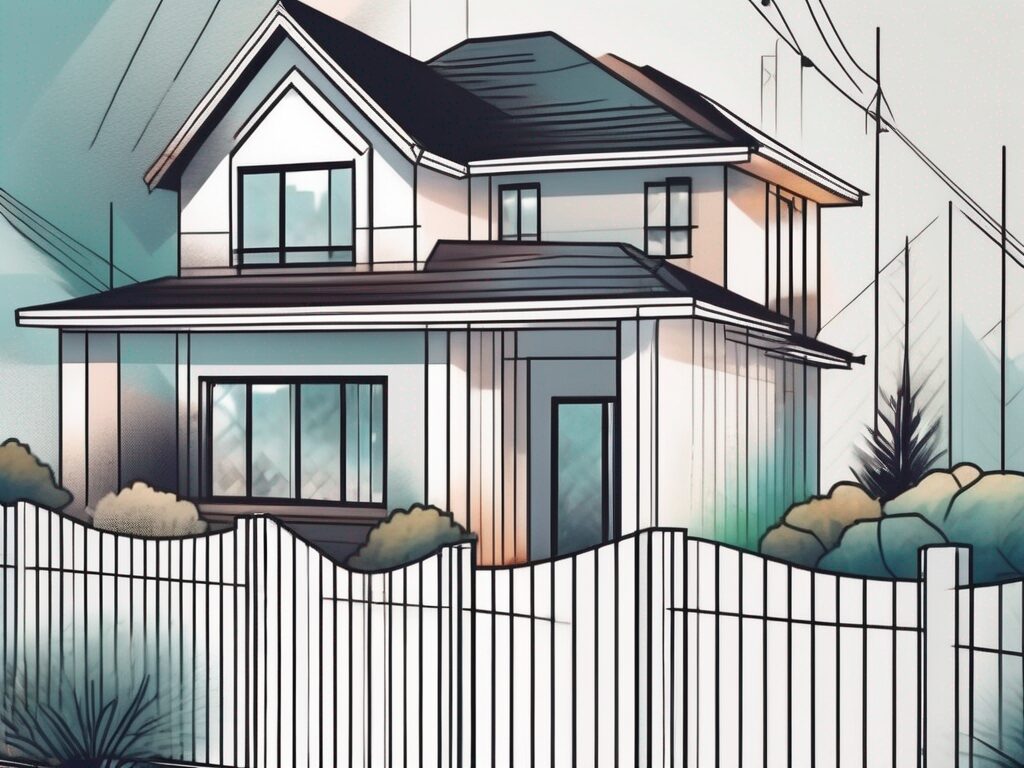
Agent A-Team or Solo Superhero? Finding the Right Real Estate Partner for Your Selling Journey in Wildwood Florida
When it comes to selling your home in Wildwood, Florida,…
January 29, 2024
When it comes to home improvement projects that can add value to your property, installing a fence is often overlooked. However, a well-designed and properly installed fence can have a significant impact on the value of your home. Not only does a fence enhance the overall appearance of your property, but it can also provide several practical benefits for homeowners. In this article, we will explore the various aspects of installing a fence and how it can affect your home’s value.
Before diving into the benefits of installing a fence, it is essential to understand the cost breakdown of building a fence. Numerous factors can influence the cost of fence installation, and being aware of them can help you make an informed decision about your investment.
One of the primary factors that affect the cost of fence installation is the size of your yard. The larger the area that needs to be fenced, the more materials and labor will be required, resulting in a higher cost. Additionally, if your yard has uneven terrain or slopes, it may require extra work and materials to ensure a level and sturdy fence.
The type of material used for the fence is another crucial factor in determining the cost. Different materials have varying price points, with some being more expensive than others. For example, if you opt for a wrought iron fence, you can expect a higher cost compared to a chain-link or wooden fence. However, it’s important to consider the durability and longevity of the material when making your decision.
When considering the cost of fence installation, it’s also important to factor in any additional features or customization options you may choose. For instance, if you want to add decorative elements, such as ornamental post caps or lattice panels, it will increase the overall cost. Similarly, if you prefer a gate with an automated opener, you can expect to pay more for the convenience and security it provides.
Labor costs are another significant aspect to consider when budgeting for fence installation. The complexity of the project and the time required for installation will impact the labor costs. If your fence requires extensive digging or if there are obstacles such as tree roots or underground utilities, it may require additional labor and specialized equipment, which can increase the overall cost.
Permit fees are often overlooked when calculating the cost of fence installation. Depending on your location, you may need to obtain a permit before installing a fence. These permits typically come with a fee, which should be factored into your budget. It’s essential to check with your local municipality or homeowner’s association to determine if a permit is required and what the associated costs are.
In some cases, structural modifications may be necessary before installing a fence. For example, if your property has existing retaining walls or slopes that need to be addressed, it may require additional work and materials to ensure a secure and level fence. These modifications can add to the overall cost of the project.
If you are on a tight budget but still want to enjoy the benefits of a fence, there are several budget-friendly options to consider. Chain-link fences are an affordable choice that provides security and durability. They are made of interlocking steel wires and are known for their low maintenance requirements. Chain-link fences are often used in commercial properties, but they can also be a practical and cost-effective option for residential purposes.
Another cost-effective option is wood fencing. Wood fences are versatile and can be customized to match your property’s style and aesthetic. They offer a timeless appeal and can be stained or painted to complement your outdoor space. Wood fences are relatively easy to install, making them a popular choice for homeowners on a budget.
When considering budget-friendly fencing options, it’s important to weigh the upfront cost against the long-term maintenance requirements. While chain-link and wood fences may be more affordable initially, they may require more maintenance and repairs over time. It’s essential to consider your budget not only for the installation but also for the ongoing maintenance of your chosen fence.
Choosing the right fencing material is crucial as it can greatly impact the overall look, maintenance requirements, and longevity of your fence. Here, we will explore some of the most popular fencing materials and their pros and cons.
Each fencing material has its unique advantages and disadvantages. For example, vinyl fencing is known for its low maintenance and long lifespan. Vinyl fences are made from a durable plastic material that is resistant to rot, rust, and insect damage. They are also available in a wide range of colors and styles, allowing you to find the perfect match for your home’s aesthetic. However, vinyl fences can be more expensive upfront compared to other materials.
On the other hand, wood fencing offers a natural and traditional look that many homeowners find appealing. Wood fences can be made from various types of wood, such as cedar, pine, or redwood, each with its own characteristics and price points. While wood fences require periodic staining or painting to maintain their appearance and protect them from weathering, they can be easily customized and repaired if needed.
Considering factors like durability, aesthetics, and maintenance requirements will help you select the right fencing material for your specific needs. If you prioritize low maintenance and longevity, vinyl fencing may be the best choice for you. However, if you value the classic charm of wood and are willing to invest time and effort into its upkeep, a wood fence could be the perfect fit.
Maintenance plays a vital role in preserving the appearance and functionality of your fence. Some materials, such as aluminum and vinyl, require minimal upkeep, making them ideal for busy homeowners. Aluminum fences are lightweight, durable, and resistant to rust, making them a popular choice for both residential and commercial properties. They can be easily cleaned with soap and water, and occasional inspections for loose screws or damaged panels are usually sufficient to keep them in good condition.
Similarly, vinyl fences require little maintenance beyond occasional cleaning with a hose or pressure washer. They do not need to be painted, stained, or sealed, saving you time and money in the long run. However, it’s important to note that vinyl fences can become brittle in extreme cold temperatures, so they may not be the best option for areas with harsh winters.
On the other hand, other materials, like wood and wrought iron, may require more attention to prevent rotting, rusting, or other issues. Wood fences should be inspected regularly for signs of decay or insect infestation. They should also be stained or painted every few years to protect them from moisture and UV damage. Wrought iron fences, while elegant and durable, can rust over time and may need to be sanded and repainted periodically to maintain their appearance.
Understanding the maintenance requirements of different fencing materials will help you plan and budget for ongoing care. If you have limited time or prefer a low-maintenance option, aluminum or vinyl fencing may be the best choice for you. However, if you enjoy the natural beauty of wood or the timeless elegance of wrought iron, be prepared to invest time and effort into their upkeep.
Before jumping into the fence installation process, there are a few essential steps you should take to ensure a smooth and successful project.
Installing a fence can be a significant investment, both in terms of time and money. Therefore, it is crucial to approach the project with careful planning and consideration. By following these steps, you can avoid potential setbacks and ensure that your fence installation is a seamless experience.
Prior to installing a fence, it is crucial to check with your local authorities and homeowner’s association regarding any rules, regulations, and permits that might apply. These regulations are put in place to maintain the aesthetics and functionality of the community.
Some communities have specific guidelines governing the height, style, and placement of fences to ensure uniformity and adherence to neighborhood standards. By obtaining the necessary permits and following local regulations, you can avoid potential conflicts and penalties in the future.
Additionally, it is essential to consider any underground utilities or easements that may affect the placement of your fence. Contacting the appropriate utility companies to mark the location of underground lines can prevent costly damages and ensure the safety of your installation.
Every property is unique, so it is essential to assess your specific needs and preferences when determining the right fence design. While the primary purpose of a fence is often to provide privacy and security, there are other factors to consider.
Noise reduction can be an important consideration, especially if you live in a busy neighborhood or near a noisy road. The right fence design can help create a more peaceful and tranquil environment within your property.
Furthermore, the aesthetics of your fence should complement the overall style of your home and landscaping. Whether you prefer a classic wooden fence or a modern metal design, consulting with a professional fence installer can help you explore different options and select the one that best complements your property.
During the assessment process, it is also essential to consider the maintenance requirements of different fence materials. Some materials may require more upkeep than others, and understanding these factors can help you make an informed decision.
By taking the time to assess your property and determine the right fence design, you can ensure that your fence not only serves its intended purpose but also enhances the overall appeal of your property.
Choosing the right fence installer can make a significant difference in the outcome of your project. To ensure a smooth and successful installation, keep the following tips and tricks in mind.
When it comes to finding a trustworthy fence installer, there are several factors to consider. First and foremost, it is essential to ask the right questions to gauge their expertise, reliability, and experience. Inquire about their licensing and insurance to ensure that they are operating legally and have the necessary coverage in case of any accidents or damages. Additionally, ask about the timeline for completion to ensure that it aligns with your expectations and needs. A reputable fence installer will be transparent about their schedule and provide you with a realistic timeframe for the project. Lastly, inquire about any warranties or guarantees they offer. This will give you peace of mind knowing that they stand behind their work and are committed to customer satisfaction.
Before hiring a fence installation professional, it is essential to ask the right questions to gauge their expertise, reliability, and experience. Inquire about their licensing and insurance, the timeline for completion, and any warranties or guarantees they offer. These questions will help you make an informed decision and choose a contractor that meets your expectations.
Another crucial aspect of finding a trustworthy fence installer is checking references and reading reviews. Doing thorough research will give you valuable insight into the quality of their work, customer satisfaction, and professionalism. Ask for references from previous clients and take the time to reach out to them. Speaking directly with past customers will provide you with an unbiased perspective on the fence installer’s performance and the overall experience they had. Additionally, reading online reviews can offer a broader range of opinions and experiences. Look for consistent positive feedback and pay attention to any negative reviews and how the fence installer addressed or resolved those issues. Remember that choosing a reputable and trustworthy fence installer will ensure a seamless installation process and a fence that enhances your home’s value.
Doing thorough research is crucial when selecting a fence installer. Ask for references from previous clients and take the time to read online reviews. Checking references and reviews will give you valuable insight into the quality of their work, customer satisfaction, and professionalism. Remember that choosing a reputable and trustworthy fence installer will ensure a seamless installation process and a fence that enhances your home’s value.
Furthermore, don’t hesitate to ask the fence installer for examples of their previous work. Seeing their craftsmanship firsthand will give you a better idea of their skill level and attention to detail. Additionally, consider visiting some of their completed projects in person, if possible. This will allow you to assess the overall quality and durability of their fences.
It’s also worth mentioning that a trustworthy fence installer will provide you with a detailed written estimate. This estimate should include a breakdown of all the costs involved, such as materials, labor, permits, and any additional fees. Having a clear understanding of the financial aspect of the project will help you avoid any surprises or hidden charges down the line.
Lastly, don’t underestimate the importance of good communication. A reliable fence installer will be responsive to your inquiries and keep you informed throughout the entire installation process. They will address any concerns or questions you may have promptly and professionally, ensuring that you feel confident and involved in the project every step of the way.
If you are considering selling your home in the near future, it is vital to assess the condition of your fence and address any necessary repairs. A well-maintained and visually appealing fence can greatly enhance your property’s curb appeal and attract potential buyers.
The first impression is crucial when selling a home, and a well-maintained fence can significantly improve your property’s curb appeal. Fixing any broken or damaged sections, repainting or staining if necessary, and ensuring that the fence is clean and free from debris will make a positive impact on potential buyers. A visually appealing fence creates a sense of security, privacy, and care, making it an attractive feature for homebuyers.
Before listing your property, take the time to address common fence issues that may arise. Loose boards, rusting metal, sagging gates, or overgrown vegetation can negatively impact the overall perception of your property. By tackling these issues and ensuring that your fence is in good condition, you can present your home in the best possible light, potentially increasing its value and attractiveness to buyers.
Buyers have varying preferences when it comes to fences, and understanding their preferences can help you make informed decisions about your fence installation.
When choosing a fence style, it is essential to consider popular options that attract homebuyers. Some of the most sought-after fence styles include traditional picket fences, modern horizontal slat fences, and elegant wrought iron fences. These styles offer a timeless appeal and are often associated with well-maintained and desirable properties.
In conclusion, installing a fence can have a significant impact on your home’s value. By considering the cost breakdown, exploring various materials, and understanding buyer preferences, you can make strategic decisions that boost your home’s curb appeal and desirability. Take the necessary steps before installation, find a trustworthy fence installer, and address any fence repairs before selling your home. With careful planning and research, you can enjoy the benefits of a well-designed fence while increasing the value of your property.

If you want the Richr team to help you save thousands on your home just book a call.
 Book a call
Book a call